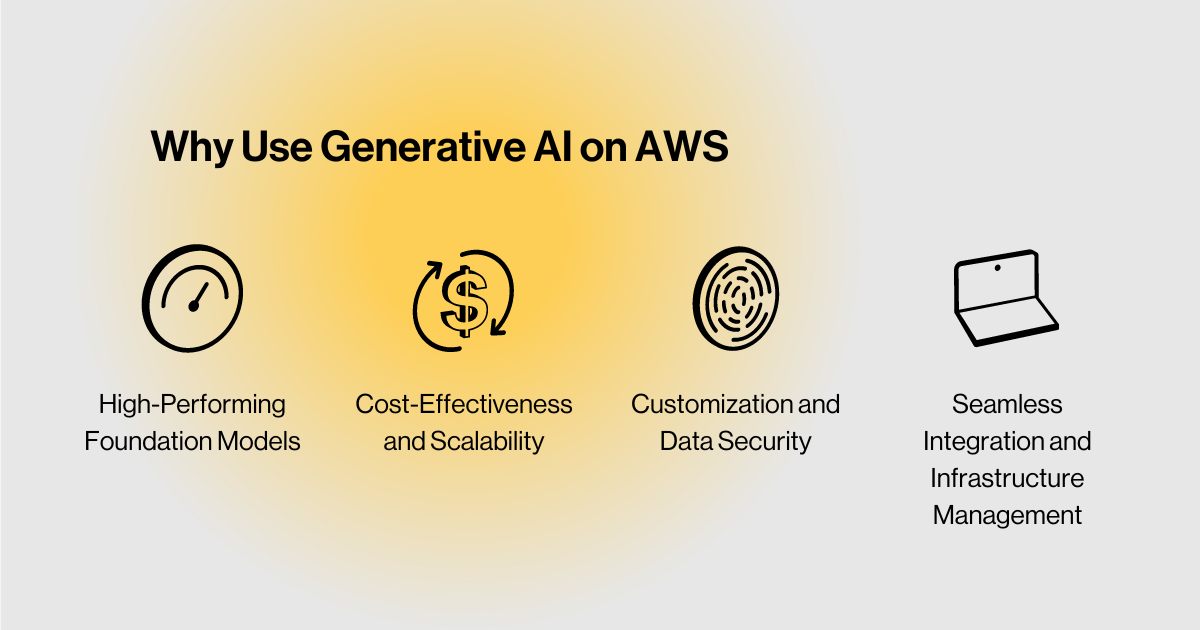Blog
Data and Generative AI Predictions for 2024 from AWS re:Invent
Generative AI took center stage at AWS re:Invent 2023, where Amazon provided updates, hinted at what’s to come and offered use cases to apply right now. With all of this in mind, we’ve developed our generative AI predictions for the year ahead.
What was clear at re:Invent is that AWS is leaning hard into AI technology. Even services that aren’t generally AI-focused included announcements about incorporating the technology. Amazon wants companies to use AI tools and technologies to offer new features, create better experiences and get users excited about integrating generative AI into their own data, products and services.
The conference focused on a central theme — how generative AI will shape the industry’s future. Let’s explore key takeaways from Amazon’s biggest event of the year and predict the future of generative AI for AWS.
4 Reasons to Use Generative AI for AWS
AWS offers a comprehensive suite of generative AI technologies and services for organizations. Here are some key reasons to take advantage.
High-Performing Foundation Models
AWS makes building generative AI applications easy with a curated selection of state-of-the-art foundation models (FMs), including Claude, Stable Diffusion and Llama 2. All of this is powered by Amazon Bedrock. These FMs have been carefully designed and trained by leading institutions and AI experts, providing outstanding performance across a variety of tasks.
Cost-Effectiveness and Scalability
AWS offers a performant, low-cost infrastructure for generative AI. With on-demand access to scalable computing resources, organizations don’t have to develop their own solutions or turn to third-party providers. AWS' infrastructure helps businesses scale enterprise applications based on demand and realize optimal performance and cost-efficiency.
Seamless Integration and Infrastructure Management
AWS makes it simple to add AI to your applications with managed large language models (LLMs) that seamlessly integrate with existing workflows. There’s no need to invest in and maintain your own infrastructure, so you save on technical costs and complexities. With AWS, businesses can leverage infrastructure designed for training and running generative AI models at scale, including GPU-based instances and purpose-built accelerators.
Customization and Data Security
AWS empowers organizations to use their own data as a differentiator. You can securely customize FMs and build differentiated applications that align with your business, data and customer requirements.
For example, a marketing company can use generative AI tools from AWS to create personalized advertising campaigns based on customer demographics, browsing behavior and purchase history. Throughout this customization process, AWS prioritizes data protection and maintains confidentiality and privacy. Organizations have full control over how their data is shared and used. Know that your intellectual property is secure and that you’re meeting compliance requirements.

What is Amazon Q?
Amazon Q is a generative AI-powered assistant tailored for work. Unlike other chat applications, Amazon Q is designed specifically for businesses. It uses enterprise data and generative AI to provide fast and relevant answers, solve problems, generate content and take action.
With seamless integration capabilities and over 40 built-in connectors, Amazon Q is designed to integrate with enterprise systems, allowing authorized users to engage in tailored conversations and receive personalized results based on access levels.
However, Amazon Q is in the early stages of development. While a promising product, it requires further refinement and enhancements to fully unlock its capabilities.
Top Generative AI Predictions
This year’s re:Invent highlighted generative AI’s future at AWS. Let’s take a closer look at key takeaways, along with our generative AI predictions for 2024.
SageMaker and Bedrock Will Continue to Evolve
In addition to adding JumpStart models, AWS is introducing SageMaker HyperPod, which simplifies the process of building and optimizing machine learning (ML) infrastructure for training models. Users can reduce training time by up to 40% by automatically splitting training workloads across thousands of accelerators. With parallel workload processing, you get improved model performance.
This feature prevents FM training interruptions by periodically saving checkpoints and automatically detecting and repairing hardware failures during training. With SageMaker HyperPod, users can train their models for weeks or months in a distributed setting. Users access a streamlined and resilient training environment that optimizes the utilization of compute, memory and network resources.
Additionally, SageMaker Canvas, AWS’ no-code AI/ML platform, now supports natural language instructions for data exploration, summarization, forecasts and more. With this update, users can easily explore and transform their data using guided prompts and queries without coding. This feature accelerates the data preparation process, which is often time-consuming, by providing over 300 built-in transforms, analyses and data quality insights.
Bedrock, meanwhile, is adding model offerings, including Titan Image Generator, which complements the existing Stable Diffusion model from Stability AI for creating images. AWS is also introducing smaller models within each family of Bedrock models. This provides cost-effective alternatives for projects that don't require everything that larger models offer. Users can more easily choose models that align with specific AI use cases while balancing cost and performance.
While large models are powerful, they can be expensive and slow to run, which is especially concerning when scaling AI capabilities to a larger user base. The future of generative AI will involve a combination of specialized models, FMs and the orchestration of routing requests to optimize performance and cost. Specialized models will cater to specific use cases, while foundation models provide a starting point for customization.
AWS Clean Rooms Will Drive Collaborative Innovation
AWS Clean Rooms, based on differential privacy, help organizations collaborate on collective data sets without sharing or copying underlying or proprietary data. Users can create secure data clean rooms with a few clicks, removing the need to build and maintain their own solutions.
Using Clean Rooms, companies can conduct data analysis while addressing concerns around data privacy, handling and ethics. Clean Rooms alters or randomizes parts of the data related to personal identification, making sure that extracted information can't be used to identify specific individuals. This preserves privacy while freeing organizations to gain in-depth insights and business benefits from large data sets.
New Apps Will Be Built Using AWS Step Functions and Amazon Bedrock
AWS Step Functions, a visual workflow service, has introduced two optimized integrations with Bedrock that allow developers to easily automate processes, orchestrate microservices and create data and ML pipelines.
Using Bedrock from workflows has required invoking an AWS Lambda function, which adds complexity and application costs. The Step Functions optimized integrations allow developers to seamlessly orchestrate tasks for building generative AI applications using Amazon Bedrock — all while integrating with more than 220 AWS services. Step Functions simplifies the development process by providing a visual interface to develop, inspect and audit workflows.
The optimized Bedrock integrations offer two new API actions. The first is the InvokeModel integration, which allows developers to invoke a model and run inferences for text, image and embedding models. The second is the CreateModelCustomizationJob integration, which creates a fine-tuning job to customize a base model. This asynchronous API integration enables Step Functions to run a job and wait for completion before moving to the next state in the workflow.
Zonal Autoshift in Route 53 Will Mitigate Traffic Challenges
Amazon Route 53 Application Recovery Controller has introduced zonal autoshift, which allows for the automatic and safe shifting of application traffic away from an AWS Availability Zone (AZ) in the event of a potential failure. Users can redirect traffic from affected AZs to healthy ones during power or networking outages — without incurring additional charges. Zonal autoshift also includes practice runs, which allow you to test AZ capacity after shifting traffic.
Once the free service is enabled, it automatically shifts application traffic away from impacted AZs and reverts back once the failure is resolved. This automated process saves time and effort, allowing organizations to focus on other aspects of application resilience.
Smaller Models Will Offer Bigger ROI
Expect a continued embrace of smaller, more specific AI models as companies look to balance performance and cost-effectiveness. The industry recognizes that not every project requires the computational power and expense associated with larger, complex models. Instead, they’re looking for comparable performance at a fraction of the cost.
Organizations can also use foundation models as a framework for routing requests to smaller models. This approach ensures that the right model is employed for each specific task.
Businesses are embracing a mindset of the right model for the job rather than the notion of a single "one-size-fits-all" model. This more nuanced approach combines specialized and foundation models.
Gen BI Will Cause Data Schemas to Be Revisited
The emergence of Gen BI (generative business intelligence), which combines generative AI and BI tools, will compel organizations to reevaluate their existing data schemas, including their limitations
Expect businesses to rebuild and refine data schemas and databases, seeking to align with the requirements of Gen BI. This process will involve redefining data models, optimizing data storage and retrieval mechanisms, and implementing more efficient data governance practices.
It's worth noting that highly regulated industries, such as healthcare, may face additional challenges in adopting emerging technologies. However, the discipline and rigor required for managing their data will provide a foundation for regulated sectors to use AI.

Leverage Tools and Services Built for Builders
When making generative AI predictions about AWS, keep in mind that the service has always prioritized builders — providing instant access to infrastructure services and empowering them to create and innovate.
AWS is committed to a multimodal future, where builders can connect and orchestrate models to create entirely new solutions. AWS' customer-centric approach produces tools and services that empower new types of builders.
For example, workflow creation capabilities through Step Functions enable complex workflows, helping builders streamline their development processes. Services like QuickSight Q provide a conversational interface that democratizes analytics for a broader range of users. Meanwhile, expect more builders to start with pre-configured projects and use code generation tools like CodeWhisper to complete their applications.
The future of generative AI and AWS is filled with opportunities, especially if you know how to capitalize on the available tools and services. Consider working with an AWS Premier Tier Services Partner, such as Mission Cloud, to unlock the fullest potential of AWS for your generative AI strategies.
Want to learn more about the Mission Cloud difference? Learn how we helped Magellan TV use genAI for international expansion.
Author Spotlight:
Mission Cloud
Keep Up To Date With AWS News
Stay up to date with the latest AWS services, latest architecture, cloud-native solutions and more.
Related Blog Posts
Category:
Category:
Category:

